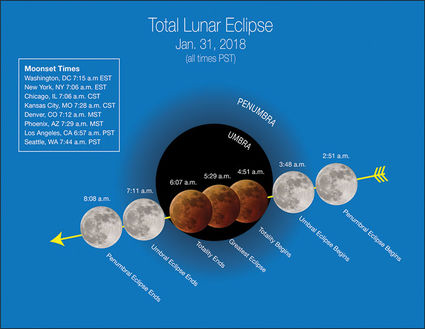Stargazers in for a treat early Wednesday morning
WORLAND - Late Tuesday night into early Wednesday morning is a once-in-a-lifetime opportunity for night sky watchers. Three amazing phenomenas are set to happen - a super moon, blue moon and lunar eclipse.
January 30, 2018

NASA
Stages of the Jan. 31, 2018 "super blue blood moon" (weather permitting) are depicted in Pacific Time with "moonset" times for major cities across the U.S., which affects how much of the event viewers will see.
WORLAND - Late Tuesday night into early Wednesday morning is a once-in-a-lifetime opportunity for night sky watchers. Three amazing phenomenas are set to happen - a super moon, blue moon and lunar eclipse.
Though each of these things individually isn't incredibly rare, the occurrence of the three things happening at once happens once every 150 years.
"A super moon is when the moon presents itself about 7 percent brighter than the average full moon," Samantha Ogden, the project coordinator at University of Wyoming's planetarium, said. "It's at its closest distance to Earth in its monthly orbit."
She added, "It's also a blue moon, and the second full moon of January. In March we'll see another blue moon, two full moons, which means that February won't have any full moons, and that's a rare occurrence as well."
"The third thing is that it's a blood moon, also known as a lunar eclipse. So early in the morning on Jan. 31, the moon will start to darken as the Earth's shadow passes in front of it. If we can see it on the horizon – in Wyoming, we're on the edge here – as the moon is setting, we may be able to see it turn a reddish color," Ogden said.
The last time these three occurred was in the year 1866.
"Blood moons – or lunar eclipses – happen about once a year, or a year and a half," Ogden said. "The last one I saw was on Halloween about two years ago. They're also not quite as rare to be seen as solar eclipses. It can also be seen by a wider portion of people at a time than as solar eclipses. Last autumn when the solar eclipse happened, it could only be seen in a narrow window across the United States. But about half of the Earth sees the lunar eclipse every time it happens."
"It begins about 4:30 in the morning, and then peaks right around 5:30, or 5:45 a.m., so just as the sun is coming up," Ogden explained. "But you'll want to wake up about 4:30 in the morning and look west to see it."
"You should be able to see it perfectly fine with the naked eye. Another nice thing about the lunar eclipse is that you don't need any certain eye protection or anything like you did with the solar eclipse. However, if there are mountains directly to the west, you may miss it, since it will be pretty low on the horizon," Ogden said. "So try and be clear of anything blocking the view on the western horizon."
"Wake up bright and early. It is cold outside, so have a cup of coffee, or some hot chocolate on hand. But then again the occurrence of all three of these things happening is an extremely rare occurrence. It will be a pretty extraordinary event. If you do accidentally sleep in and miss it, we'll have another lunar eclipse within a year or so."
Sadly, National Weather Services out of Riverton has confirmed the possibility of rain or snow before 7 p.m. on Tuesday night, and snow to follow through with the rest of the evening so cloud coverage is expected.
According to the NWS, Wednesday morning temperatures at the time of the eclipse are forecast for 15 degrees.
According to the Associated Press totality will last more than an hour.




